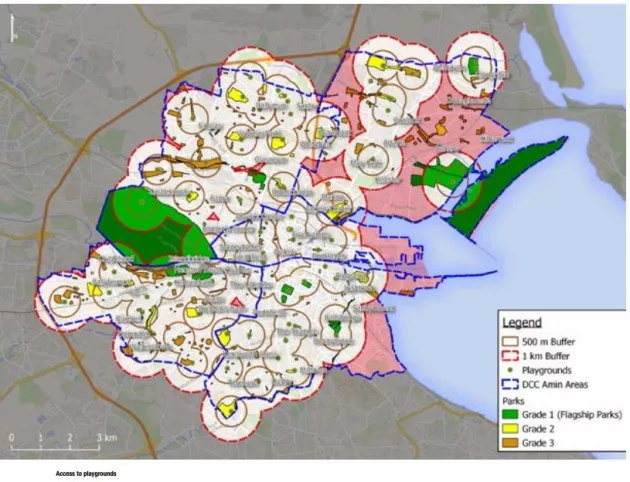4.3 Parks and Play
4.3 Parks and Play
Play is an important activity in the development of children as it promotes their physical and cognitive development and encourages socialisation. The provision of public playgrounds creates space in the city for children and their guardians to come together and enjoy play and they have become important places for local communities. Dublin City Council’s vision is for Dublin to be a playful city where all children can enjoy their right to play. Children’s right to engage in play and recreational activities is enshrined in Article 31 of the UN Convention of the Rights of the Child.
Playgrounds vary in size and type from large playgrounds with many pieces of play equipment in park settings, to smaller playgrounds with fewer pieces of equipment set closer to home. Significant investment has been made in playground development in parks and urban regeneration projects around the city; where children and young people have been consulted during the design process and where new and challenging pieces of play equipment have been installed.
Dublin City Council provides playgrounds (60) in public parks, which are located so as to cater for the needs of local neighbourhoods. There are also play facilities (62) provided in social housing schemes which service a need for play within the individual housing schemes. These are generally not accessible to the wider community so are not categorised as public playgrounds.
In the past there has been no measure as to how widely playgrounds should be distributed within a city. However, international best practice now seeks to set thresholds for access and proximity for communities to playgrounds and this can be measured by mapping the playgrounds against population distribution and density.
There is a hierarchy of playgrounds. Larger parks, such as St Anne’s Park, have the infrastructure and capacity to accommodate what are termed ‘destination’ playgrounds. These are playgrounds which people will travel to from a wider area and where there is the space for ancillary facilities, such as car parking, toilets and perhaps a café. Other than St Anne’s Park and the Phoenix Park, there are no playgrounds which would be categorized at present as ‘destination’. It should be noted that people do travel from the City Council area to park playgrounds in adjoining administrative areas, such as Malahide Demesne, Tymon Park, Templeogue, Marlay Park and Booterstown. However, there is the potential to develop such destination playgrounds in the City in the north west, south central and south east as well as the city centre.
In addition to St Anne’s Park there are local playgrounds which have a range of equipment and would each have cost in the order €150,000 to construct.
There are also a number of small playlots which have a limited range of equipment and limited value other than to the immediate environs. For the purposes of mapping play facilities citywide, the facilities in social housing are also categorized as playlots.
In order to prioritise the provision of new playgrounds, census data were reviewed for deficit areas. This indicates areas with higher concentrations of children who would benefit from new playgrounds. The distribution of all playgrounds is illustrated on the plan below.
Access to playgrounds is assessed using a 500m (5-10minutes walk) and 1000m (10-20 minutes) walk-in zone. The 500m zone provides a good level of access, while the 1000m represents a reduced level of access. The mapping of play facilities based on these thresholds highlights a defecit of provision in:
Belmayne / Kilbarrack
Coolock
Clontarf
Marino North
Sandymount
Natural play areas offer an alternative to mainstream playgrounds. They involve a more creative design of play spaces that can include natural elements such as surface mounding, sand, water, timber logs, willow tunnels, etc. They are suitable in certain locations and may take their design inspiration from particular places, such as woodlands and coastlines and give children a link to nature, which is important in the city environment.
Policy
- The City Council will continue to maintain and upgrade existing playgrounds and improve access to play for all children of Dublin City with a priority on current areas lacking provision but having a high population of children.
- To provide for new destination playgrounds in the North West, South Central, South East and City Centre.
- To assess the potential of provision of natural play through out the city to compliment the fixed playground resource.
Action
- To address deficit in provision of playgrounds and to prioritise their provision based on areas with higher population of children, the following locations will be assessed for the provision of new facilities:
North Central Area:
Belmayne
Kilbarrack
Coolock
Marino North
Clontarf
South East Area:
Sandymount
